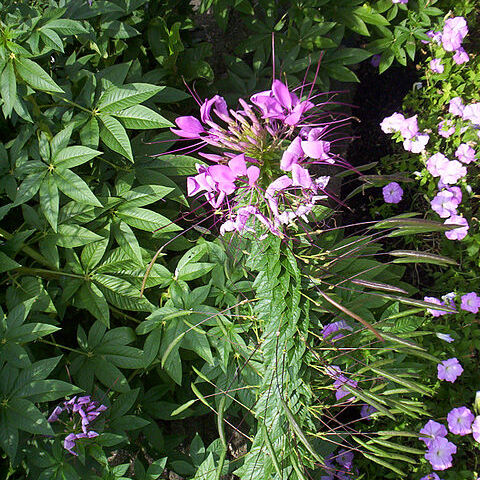Herbs [rarely shrubs], sometimes woody at base, producing mustard oils. Stems erect, sparsely or profusely branched, glabrous or glandular pubescent. Stipules scalelike or absent, caducous (petiolar spines sometimes present). Leaves alternate, spirally arranged, palmately compound; petiole often pulvinate; leaflets [1 or]3-7[-11]; leaflet blades with pinnate venation. Inflorescences racemes or corymbs or flowers solitary and axillary; peduncle present; bract present [or absent] at base of pedicels. Pedicel present; bracteoles absent. Flowers bisexual but sometimes appearing unisexual due to incomplete development, actinomorphic or slightly zygomorphic, rotate, crateriform, campanulate, or urceolate, hypogynous. Sepals 4, distinct or basally connate, persistent. Petals 4, distinct, imbricate, attached directly to receptacle; intrastaminal nectary-disk or glands present or sometimes absent. Stamens 6(-32); filaments free or basally adnate to gynophore (or along basal 1/3-1/2 in Gynandropsis); anthers dehiscing by longitudinal slits; pollen shed in single grains, 2-nucleate, commonly 3-colporate. Pistil 1, 2-carpellate; ovary superior; ovules 1 to many per locule, 2-tegmic, anatropous, placentation parietal; style 1, straight, short, thick; stigma 1, capitate, unlobed. Fruit an elongate capsule, ± dehiscent by lateral valves along their entire length [indehiscent or dehiscent schizocarp], usually stipitate from elongation of gynophore (lacking in Arivela). Seeds 1-10(-40) per capsule, tan, yellowish brown, or brown, cochleate-reniform, papillose or tuberculate, arillate or not; endosperm scanty or none but a persistent perisperm sometimes present.
Annual or perennial herbs or subshrubs, rarely shrubs; glabrous or indumentum of simple glandular or eglandular hairs; stems sometimes armed. Leaves alternate, usually palmately compound, sometimes simple; stipules usually present; leaflets usually 3–7; venation pinnate. Inflorescence axillary or terminal, a raceme or corymb, sometimes flowers solitary, usually bracteate. Flowers bisexual, actinomorphic to slightly zygomorphic. Sepals 4, free or fused basally, sometimes deciduous; petals 4, free, equal or unequal, variously coloured. Stamens 6–27 (–35), sometimes some or all reduced to staminodes; filaments free or basally fused to gynophore, nectaries sometimes associated with stamens; anthers dehiscing by longitudinal slits. Gynoecium usually 1-or 2-carpellate. Ovary superior, 2-locular, ovules 1–many per locule; style 1, stigma capitate; placentation parietal. Fruit usually a dry pedicellate capsule, usually dry lateral valves, with a persistent, thin, hoop-like woody placenta. Seeds reinform or horseshoe-shaped to coiled or conduplicate, smooth to tuberculate, often exarilate.

